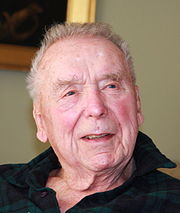- Charles Snead Houston
-
For other people named Charles Houston, see Charles Houston (disambiguation).
Charles Snead Houston 
Born August 24, 1913
New York City, New YorkDied September 27, 2009 (aged 96)[1]
Burlington, VermontEducation Harvard College; Columbia University College of Physicians and Surgeons Occupation Physician; Mountaineer; Scientist; Peace Corps Administrator Spouse Dorcas Tiemeyer Houston, Children 1 daughter Penny, and two sons David and Robin. Parents Oscar Rempel Houston and Nelly Snead MacDonald Charles Snead Houston (August 24, 1913 – September 27, 2009) was an American physician, mountaineer, high-altitude investigator, inventor, author, film-maker, and former Peace Corps administrator. He made two important and celebrated attempts to climb the Himalayan mountain K2.
Contents
Early life and education
Houston was born in New York in 1913 and grew up in Great Neck on Long Island. He was educated at Harvard University and earned a Doctor of Medicine from Columbia University College of Physicians and Surgeons.
Mountaineering
In 1936, Houston was a member of a celebrated expedition led by the British climber H.W. Tilman to the top of Nanda Devi in India, the highest mountain climbed at that time. In 1938, he was the leader of the first American Karakoram expedition to K2. Although he did not reach the summit, his party mapped a route to the top that was later used by the Italian team that first summited the mountain in 1954.
He attempted K2 again in 1953 (see Third American Karakoram Expedition). A member of the team, Art Gilkey, became ill (probably with thrombophlebitis) as they approached the summit. The team reversed direction and tried to carry Gilkey down. However, he was lost in a disastrous cascade of events which included a fall in which the rest of the roped-together team survived only by virtue of a single ice axe that suspended them all. This feat, that came to be known as "The Belay" was performed by Pete Schoening.[2][3]
Medical practice and teaching
Houston practiced internal medicine in Exeter, New Hampshire and Aspen, Colorado. Later, he joined the faculty at the University of Vermont as Professor of Medicine. He retired from the faculty in 1979.
Medical research
Houston began his study of the effects of high altitude as a naval flight surgeon in World War II. He was in charge of Operation Everest (1947) in which four subjects were taken to a simulated altitude of 8850 m over 34 days in a compression chamber. These studies demonstrated that careful acclimatization would allow pilots to fly unpressurized planes to altitudes of 15,000 feet and higher. This capacity afforded the US Army Air Corps an important tactical advantage.
He was among the first to study High Altitude Pulmonary Edema (1958), and High Altitude Retinal Hemorrhage (1968). He authored numerous books and articles about mountain medicine. Starting in 1975, he organized the International Hypoxia Symposia in the Canadian Rockies.
In 1996 he was awarded the King Albert Medal of Merit to honor his "singular achievements" in the mountain world [1].
Houston was also involved with early attempts to construct an artificial heart. Although not successful, his design was influential in later developments, including the Jarvik-7 model that was used with some success.
Peace Corps service
From 1962 to 1965, Houston served as the first Country Director of the Peace Corps for India. During his tenure, the volunteers in India grew from 6 to 250. He was instrumental in developing a doctors' division within the Corps.
Works by Charles S. Houston
Robert H. Bates and Charles H. Houston (1939). Five Miles High. New York, NY: The Lyons Press.
Charles H. Houston and Robert H. Bates (1954). K2, The Savage Mountain. New York, NY: The Lyons Press.
Charles S. Houston (1980). Going high, the story of man and altitude. American Alpine Club.
Charles S. Houston (1982). High Altitude Physiology Study: Collected Papers. Arctic Institute of North America.
John R. Sutton, Charles S. Houston, Geoffrey Coates (eds.) (1987). Hypoxia and cold. New York: Praeger.
Charles Houston (1993). High altitude: illness and wellness. Merrillville, IN: ICS Books.
Charles Houston (2005). Going Higher: Oxygen Man and Mountains (5th ed. ed.). Seattle, WA: The Mountaineers Books.
References
Bernadette McDonald (2007). Brotherhood of the Rope: The biography of Charles Houston. Seattle, WA: The Mountaineers Books.
External links
- Dr Charles Houston - Daily Telegraph obituary
- Doctor Charles Houston Independent obituary, 1 October 2009.
Notes
- ^ "Doctor, climber Houston dies at 96". Burlington free Press. 2009-09-30. http://www.burlingtonfreepress.com/article/20090930/NEWS02/909300310/Doctor--climber-Houston-dies-at-96.
- ^ "Schoening Ice Axe". Bradford Washburn American Mountaineering Museum. http://bwamm.blogspot.com/2007/12/famed-schoening-ice-axe.html.
- ^ Rowell, Galen (1977). In The Throne Room of the Mountain Gods. San Francisco: Sierra Club Books. pp. 226–234. ISBN 0-87156-184-0.
Categories:- American mountain climbers
- American physicians
- Harvard University alumni
- Columbia Medical School alumni
- 1913 births
- 2009 deaths
Wikimedia Foundation. 2010.
